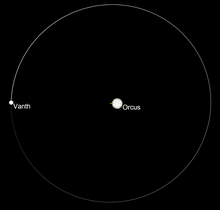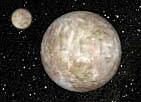Vanth (moon)
| (90482) Orcus I (Vanth) | |
|---|---|
| Provisional or systematic name | S / 2005 (90482) 1 |
| Central body | (90482) Orcus |
| Properties of the orbit | |
| Major semi-axis | 8999 ± 9 km |
| Periapsis | 8991 km |
| Apoapsis | 9007 km |
| eccentricity | 0.0009 ± 0.0006 |
| Orbit inclination | 90.2 ± 0.6 ° |
| Orbital time | 9.53916 ± 0.00002 d |
| Mean orbital velocity | 0.034 km / s |
| Physical Properties | |
| Albedo | 0.08 ± 0.02 |
| Apparent brightness | 21.97 ± 0.05 mag |
| Medium diameter | km |
| Dimensions | ≈ 1.10 · 10 15 kg |
| surface | 615,000 km 2 |
| Medium density | ≈ 1.5 ± 0.3 g / cm 3 |
| Sidereal rotation | 9.53916 ± 0.00002 d |
| Surface temperature | ≈ 44 K |
| discovery | |
| Explorer |
Michael E. Brown |
| Date of discovery | November 13, 2005 |
| Remarks | Probably bound rotation. |
Vanth is the first known moon of Plutino and dwarf planet candidate (90482) Orcus , which is classified as Plutino in terms of orbital dynamics. According to current knowledge, Vanth has about half the diameter of the mother asteroid; therefore this system can also be understood as a double asteroid system.
Discovery and naming
Vanth was discovered by Mike Brown and Terry-Ann Suer in images from the Hubble Space Telescope on November 13, 2005. Vanth was found at 0.25 ± 0.1 arc seconds from Orcus, with a difference in apparent magnitude of 2.7 ± 1.0. The discovery was announced on February 22, 2007; the moon was given the provisional designation S / 2005 (90482) 1 .
On March 23, 2009, Brown urged readers of his weekly column to suggest an appropriate name for the new moon, with the best of them submitting to the IAU on April 5, 2009 . The name Vanth was chosen from a wide range of proposals. Vanth was the only name that was purely Etruscan in origin . It was the most popular suggestion that came first from Sonya Taafe.
On April 7, 2010, the moon was officially named by the International Astronomical Union (IAU) after the psychopompos Vanth , a female demon in Etruscan mythology who accompanied the souls of the deceased into the underworld. Sometimes she carried scrolls on which the deeds of the deceased were recorded. Vanth appears on tomb paintings or sarcophagi, where she is usually portrayed with large wings, white clothes and a torch. She occasionally appears as a youthful companion to Charun , which is why Vanth is often associated with Charon , just as Orcus (nickname: "Anti-Pluto", since the orbital resonance to Neptune Orcus keeps almost on the opposite side of the sun ) has parallels to Pluto .
Since its discovery, Vanth has been observed through various telescopes such as the Spitzer and Hubble as well as earth-based telescopes and its orbital elements have been determined. (As of March 4, 2019)
Track properties
Vanth orbits Orcus in an almost perfectly circular orbit at an average distance of 8,999 kilometers from its center (19.63 Orcus radii and 40.67 Vanthradia). The orbit eccentricity is a maximum of 0.001, the orbit is 90.20 ° (other information: 73 ° or 109 °) inclined to the ecliptic .
Vanth circles the joint center of gravity with Orcus in 9 days, 12 hours and 56.4 minutes, which corresponds to 9421.5 self- rotations ("days") in an Orcus year (around 246.06 earth years). In this binary system, one month - based on the currently most likely Orcus rotation periods - accordingly lasts 23.6 to 24.0 Orcus days . Brown assumes that Vanth, like most planetary moons, has a bound rotation , so Orcus always shows the same side.
It is believed that the moon is likely a trapped object of the Kuiper Belt as it does not resemble the other "collision moons" very much. Vanth would be influenced by the so-called Kozai effect , which means that the orbit inclination and eccentricity are coupled to one another (the orbit inclination and the periapsis decrease when the eccentricity increases, and vice versa). However, since the almost circular path speaks against it, a collision cannot be ruled out.
Size and mass
At first, the same reflectivity and the same density as that of the central body were assumed and a diameter of 262 km, which corresponds to about a quarter of the diameter of Orcus. In 2009 Brown assumed a size of 31% of the main body, from which a diameter of 280 km was derived. However, observations of a star eclipse in March 2017 showed a diameter of 442.5 km, which increases the size to half that of Orcus and is therefore comparable to the size ratio of the Pluto - Charon system. This also results in a significantly darker albedo of around 9% compared to the main body; the reflectivity of Orcus, on the other hand, is an unusually high 23% for a trans-Neptunian object . Since Vanth, in contrast to Orcus, is more reddish in color, it is quite possible that the albedo is darker by a factor of two, which would correspond to a diameter of even 640 kilometers (more than half the diameter of Orcus).
By analyzing the orbit, the mass of the Orcus-Vanth system could be determined to be 6.41 ± 0.19 · 10 20 kg. How the mass is distributed between Orcus and Vanth depends on their size ratio. If the diameter of Vanth were about a third of the Orcus diameter, its mass would only make up 3% of the system mass, with half the Orcus diameter, which roughly corresponds to the current diameter determination, the mass of Vanth could be up to 1/12 of the system mass or 8% of the Orcus mass, which corresponds to about 1.10 · 10 15 kg. The same mean density of 1.5 g / cm 3 as that of Orcus is assumed for Vanth .
| year | Dimensions km | source |
|---|---|---|
| 2010 | 280.0 | Brown et al. a. |
| 2011 | 312.6 | Grundy et al. a. |
| 2011 | 267.0 ± 100.0 | Carry u. a. |
| 2013 | 276.0 ± 17.0 | Fornasier et al. a. |
| 2014 | <225.0 | Thirouin et al. a. |
| 2017 | 370.0 +170.0−70.0 | Brown et al. a. |
| 2018 | 475.0 ± 75.0 | Brown et al. a. |
| 2018 | 442.5 ± 10.2 | Sickafoose u. a. |
| The most precise determination is marked in bold . | ||
surface
The moon is too close to Orcus to be able to determine the composition of its surface spectroscopically with earth-based telescopes . When observed through the Hubble Space Telescope , the red color, which deviates from Orcus, could at least be determined. In contrast to Orcus, no absorption of water ice could be detected in the infrared spectrum .
Assuming a diameter of 442.5 km, this results in a total surface of around 615,000 km 2 . The apparent brightness of Vanth is 21.97 m , the mean surface temperature is estimated at 44 K (−229 ° C) based on the distance from the sun .
See also
- List of moons from asteroids
- List of moons of planets and dwarf planets
- List of trans-Neptunian objects
- List of asteroids
Individual evidence
- ^ A b Wm. R. Johnston: Asteroids with Satellites - (90482) Orcus and Vanth . Johnston's Archives. September 20, 2014. Accessed March 4, 2019.
- ↑ a b c W. Grundy: TNBs with known P, a, and e . Lowell Observatory . September 14, 2014. Retrieved February 8, 2019.
- ↑ M. Brucker et al. a .: High Albedos of Low Inclination Classical Kuiper Belt Objects (PDF) . In: Icarus . 201, No. 1, December 18, 2008. arxiv : 0812.4290 . bibcode : 2009Icar..201..284B . doi : 10.1016 / j.icarus.2008.12.040 .
- ↑ a b M. Brown et al. a .: Medium-sized satellites of large Kuiper belt objects . In: The Astronomical Journal . 156, No. 4, January 22, 2018, p. 164, 6. arxiv : 1801.07221 . bibcode : 2018AJ .... 156..164B . doi : 10.3847 / 1538-3881 / aad9f2 .
- ↑ a b c W. Grundy u. a .: Five New and Three Improved Mutual Orbits of Transneptunian Binaries (PDF) . In: Icarus . 213, No. 2, March 14, 2011, pp. 678-692. arxiv : 1103.2751 . bibcode : 2011Icar..213..678G . doi : 10.1016 / j.icarus.2011.03.012 .
- ↑ a b A. Sickafoose u. a .: A stellar occultation by Vanth, a satellite of (90482) Orcus (PDF) . In: Earth and Planetary Astrophysics . October 21, 2018, p. 37. arxiv : 1810.08977 . doi : 10.1016 / j.icarus.2018.10.016 .
- ^ Marc W. Buie : Orbit Fit and Astrometric record for 90482 . SwRI (Space Science Department). Retrieved March 4, 2019.
- ↑ MPC : MPEC 2010-S44: Distant Minor Planets (2010 OCT.11.0 TT) . IAU . September 25, 2010. Accessed March 4, 2019.
- ^ W. Grundy: Orbit Status of Known Binary TNOs . Lowell Observatory . Retrieved March 4, 2019.
- ^ D. Green: Satellites of 2003 AZ_84, (50000), (55637), and (90482) . In: IAU : Central Bureau for Astronomical Telegrams (CBAT) . February 22, 2007. bibcode : 2007IAUC.8812 .... 1B .
- ↑ a b M. Brown et al. a .: The size, density, and formation of the Orcus-Vanth system in the Kuiper belt (PDF) . In: The Astronomical Journal . 139, No. 6, October 26, 2009, pp. 2700-2705. arxiv : 0910.4784 . bibcode : 2010AJ .... 139.2700B . doi : 10.1088 / 0004-6256 / 139/6/2700 .
- ↑ a b B. Carry u. a .: Integral-field spectroscopy of (90482) Orcus-Vanth . In: Astronomy & Astrophysics . 534, No. A115, October 18, 2011. arxiv : 1108.5963 . doi : 10.1051 / 0004-6361 / 201117486 .
- ↑ S. Fornasier et al. a .: “TNOs are Cool”: A survey of the trans-Neptunian region. VIII. Combined Herschel PACS and SPIRE observations of nine bright targets at 70-500 µm . In: Astronomy and Astrophysics . 555, No. A15, June 19, 2013, p. 22. arxiv : 1305.0449v2 . bibcode : 2013A & A ... 555A..15F . doi : 10.1051 / 0004-6361 / 201321329 .
- ↑ A. Thirouin et al. a .: Rotational properties of the binary and non-binary populations in the Trans-Neptunian belt . In: Astronomy and Astrophysics . 569, No. A3, July 5, 2014, p. 20. arxiv : 1407.1214 . bibcode : 2014A & A ... 569A ... 3T . doi : 10.1051 / 0004-6361 / 201423567 .
- ^ M. Brown : The Density of Mid-sized Kuiper Belt Objects from ALMA Thermal Observations . In: The Astronomical Journal . 154/1, July 7, 2017, p. 19, 7. arxiv : 1702.07414 . bibcode : 2017AJ .... 154 ... 19B . doi : 10.3847 / 1538-3881 / aa6346 .


